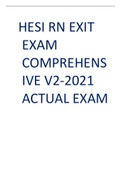Samenvatting
Summary Lecture 2 and literature - Genes and Pharmacology
- Vak
- Neurocognition
- Instelling
- Universiteit Leiden (UL)
This is an extensive summary of the second given lecture and corresponding literature about genes and pharmacology of the course Neurocognition.
[Meer zien]













